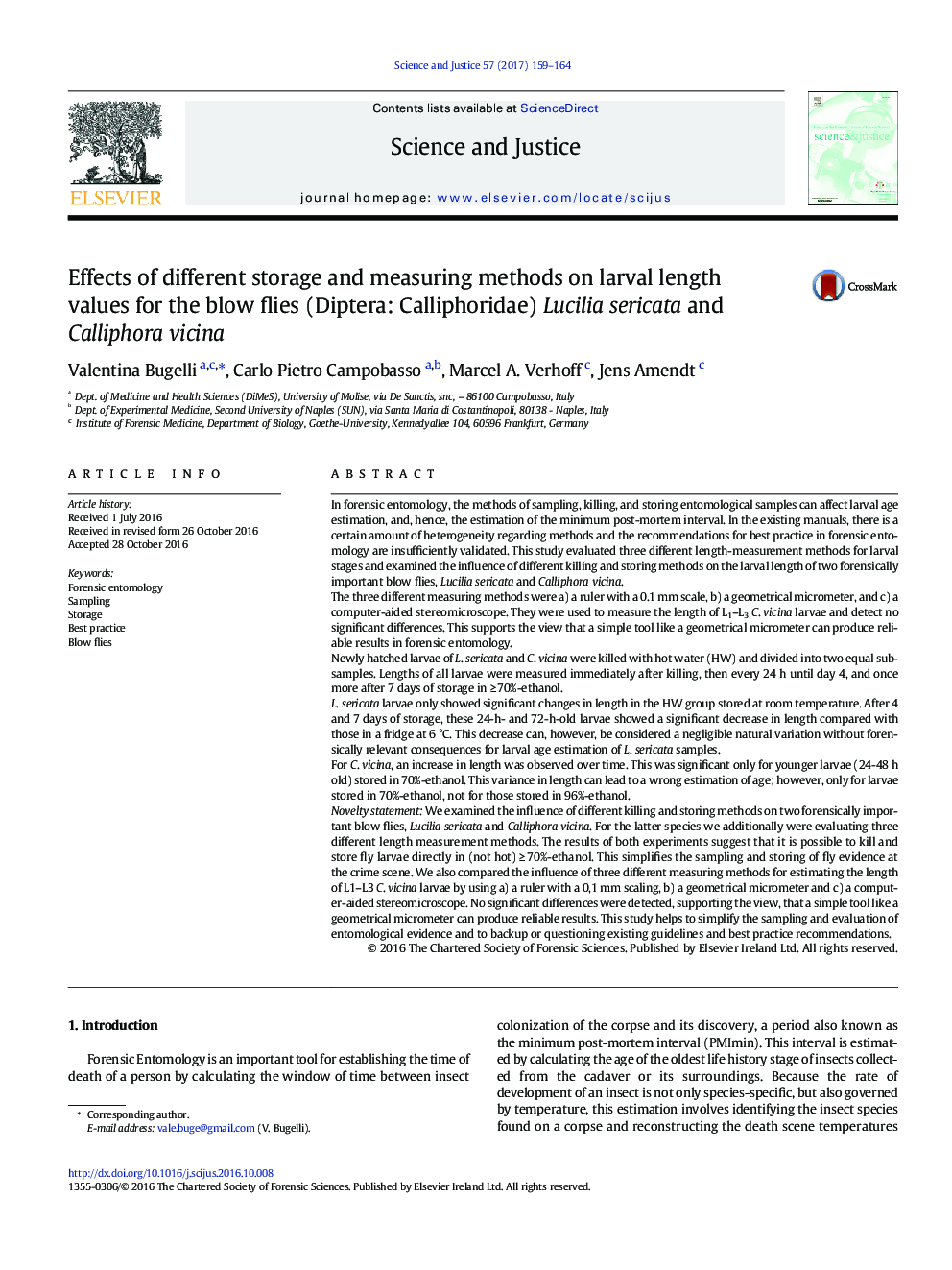| کد مقاله | کد نشریه | سال انتشار | مقاله انگلیسی | نسخه تمام متن |
|---|---|---|---|---|
| 6463377 | 1362099 | 2017 | 6 صفحه PDF | دانلود رایگان |
- Blow fly larvae can be measured accurately with a geometric micrometer.
- Age estimation can be wrong for larval samples stored in 70%-ethanol.
- Storing blow fly larvae in 96% ethanol does not affect age estimation.
In forensic entomology, the methods of sampling, killing, and storing entomological samples can affect larval age estimation, and, hence, the estimation of the minimum post-mortem interval. In the existing manuals, there is a certain amount of heterogeneity regarding methods and the recommendations for best practice in forensic entomology are insufficiently validated. This study evaluated three different length-measurement methods for larval stages and examined the influence of different killing and storing methods on the larval length of two forensically important blow flies, Lucilia sericata and Calliphora vicina.The three different measuring methods were a) a ruler with a 0.1 mm scale, b) a geometrical micrometer, and c) a computer-aided stereomicroscope. They were used to measure the length of L1-L3C. vicina larvae and detect no significant differences. This supports the view that a simple tool like a geometrical micrometer can produce reliable results in forensic entomology.Newly hatched larvae of L. sericata and C. vicina were killed with hot water (HW) and divided into two equal subsamples. Lengths of all larvae were measured immediately after killing, then every 24 h until day 4, and once more after 7 days of storage in â¥Â 70%-ethanol.L. sericata larvae only showed significant changes in length in the HW group stored at room temperature. After 4 and 7 days of storage, these 24-h- and 72-h-old larvae showed a significant decrease in length compared with those in a fridge at 6 °C. This decrease can, however, be considered a negligible natural variation without forensically relevant consequences for larval age estimation of L. sericata samples.For C. vicina, an increase in length was observed over time. This was significant only for younger larvae (24-48 h old) stored in 70%-ethanol. This variance in length can lead to a wrong estimation of age; however, only for larvae stored in 70%-ethanol, not for those stored in 96%-ethanol.Novelty statementWe examined the influence of different killing and storing methods on two forensically important blow flies, Lucilia sericata and Calliphora vicina. For the latter species we additionally were evaluating three different length measurement methods. The results of both experiments suggest that it is possible to kill and store fly larvae directly in (not hot) â¥Â 70%-ethanol. This simplifies the sampling and storing of fly evidence at the crime scene. We also compared the influence of three different measuring methods for estimating the length of L1-L3 C. vicina larvae by using a) a ruler with a 0,1 mm scaling, b) a geometrical micrometer and c) a computer-aided stereomicroscope. No significant differences were detected, supporting the view, that a simple tool like a geometrical micrometer can produce reliable results. This study helps to simplify the sampling and evaluation of entomological evidence and to backup or questioning existing guidelines and best practice recommendations.
Journal: Science & Justice - Volume 57, Issue 3, May 2017, Pages 159-164
